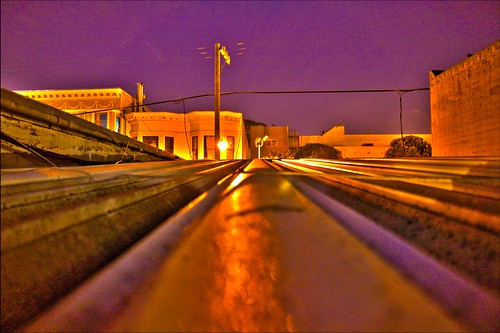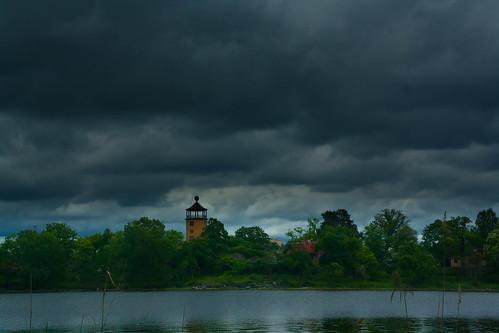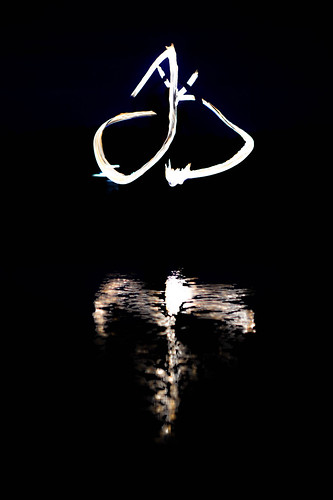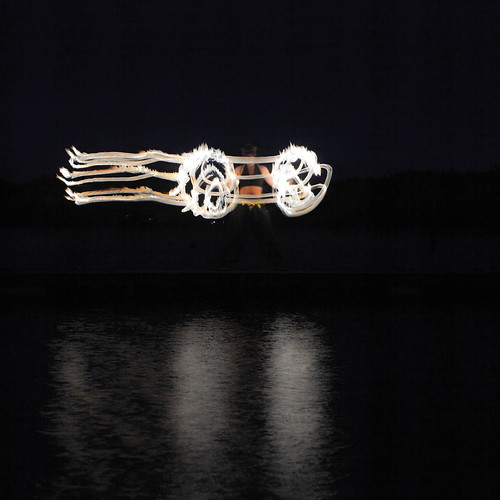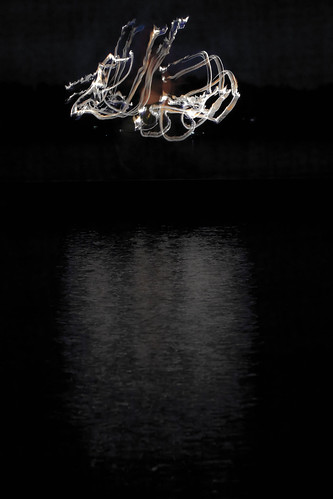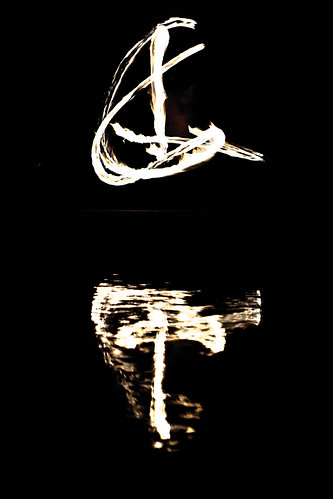A picture a day group photoblogging. We shall each publish one new original photograph each day, taken within a week of publication.
Saturday, October 1, 2011
Fnittriga bilder
Framed by the two Stockholm scenes in their tranquil blue tones, the portraits of a glass of Strega on a San Francisco rooftop flank the perspective-highlighting rooftop in corrugated steel and brash purple sky. All of these photos have a touch of the psychedelic, that with the mood itself, rises through the sequence, peaks with the purple picture, and then decays again until the dramatic sky over Brunnsviken looks almost normal to the dazed spectator emerging after the picture sequence.
Wednesday, September 14, 2011
Monochromatic fire dance
As I started looking over the photos from my recent photo shoot with the firedancing group Incendia, I noticed that the textures in several of the photos were by far the most eye-catching part. Experimenting a bit with black/white treatments, as well as twiddling the white balances and the saturations — just to see what an extreme modification might do to the picture — I ended up settling for this particular look for a handful of my pictures.
Photoshop and Photoshop Lightroom have two different approaches to saturating and desaturating images: one straightforward, and one that tries to care about skin tones (vibrance). As it turned out, by some experimentation, aggressive desaturation complemented by aggressive vibrance increase lends us this look, where the fire loses its saturation, its coloration, and fades into these almost black/white textured streaks, while skintones and the clothing of the dancer stay clear.
This treatment highlights the texture in the fire, while simultaneously emphasizing the dancer in the photos where she shows up clearly and cleanly, boosting the contrast between the moving fires and the (relatively) immobile dancer.
As for the composition of the collection, the two calligraphic-looking shots form a nice diptyk, framing the entire series; with the Parallell Transport a nice and directional way to lead the eye inwards, and the swirling picture a good, balanced and … centralized centerpiece.
Thursday, September 1, 2011
[Admin] Pic-a-day turns into compositions and collections
 |
| Still one of the images I'm most proud of. If only I could articulate just WHAT it is that speaks to me… |
I've just finished my year long picture-a-day pledge. And this means it is time to go in a new direction. The new direction I am choosing for this blog is rooted in some exercises I did back in July, and I'd like to tell you about this background in order to sketch out where I'm going from here.
I went to visit my dear Aunt July 24-27 this year. At the core of the reason for my visit was to pick her brain on composition, and on art as an occupation. So she ran me through a number of exercises, all of which were similar in character, and all of which set out to train me in seeing picture compositions, using picture compositions, and curate my own picture material into selections that actually express something tangible, something that will, with any luck, speak to the watcher.
So this is what I will be doing here. I will still be taking new photographs, but starting today, this blog is no longer focused on displaying a picture a day. Instead, I will pledge to one post every week — alternating (unless I want to do something else with the platform at the moment) between thoughts on composition, on curation and on other aspects of being an artist on the one hand and explicit curation with explanations of the message I think I am sending and the thoughts that went into the creation of any given photo set on the other hand.
This is, with quite some margin, the next big thing for me to work on.
I hope it will be as enjoyable for you as it is for me.
Proud and surprised faces of Stockholm
Here, as my first collection, a sampling from the faces watching our float.
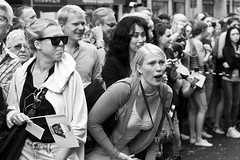
|
 |
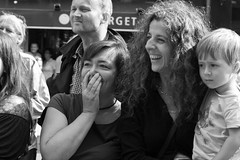 |
 |
 |
 |
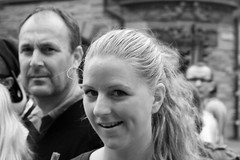 |
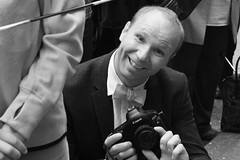 |
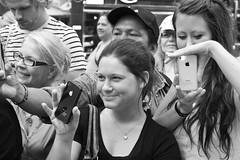 |
It is always a wonderful feeling to walk the parade — the sheer weight of the audience's attention on you gives me an adrenaline and endorphin rush that has few equals. One way I try to capture it is to seal some of the attention and reactions we elicited, to gather them and arrange them.
You should be able to click the pictures to get a better view of each picture showing up, and — as always — all my pictures are on my flickr account.
Tuesday, August 30, 2011
Young drummers
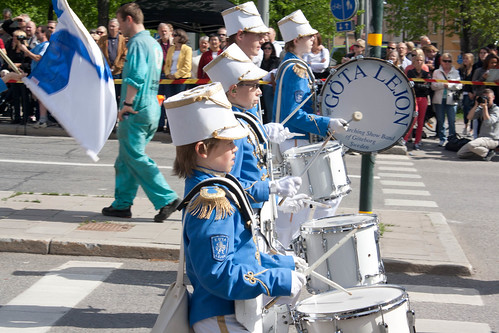 |
| Göta Lejons ungdomsorkester |
I got this shot from the sidelines. I find it attractive because of how it combines a strong sense of pattern — the hats, the drums, all lining up — at least as well as can be expected by a youth marching band; and then the concentrated faces of the drummers, looking straight ahead, working their way through their beat patterns.
It is a picture that ends up being very personal at the same time as it is almost abstract.
The tilt of the horizon? Actually a result of my laziness; but it ends up conveying a directionality, reinforcing the sense that they are moving forwards with the parade.
Monday, August 29, 2011
Jump!
 |
| Jump! |
There are things I would have liked differently in this picture — it's a somewhat busy background, and I could have gotten better separation between dancers and backdrops; but it's not that bad. The things I want to show: the dancers, the drums and drumsticks, the energy and action of the performance all come through as cleanly and clearly as anything. For the amount of snapshotting — of taking, not making, a photograph that went into this, I am quite happy with the results. Convincing, illustrative, emotional. A fair shot.
Sunday, August 28, 2011
Kungsgatstornet
 |
| Kungsgatstornet |
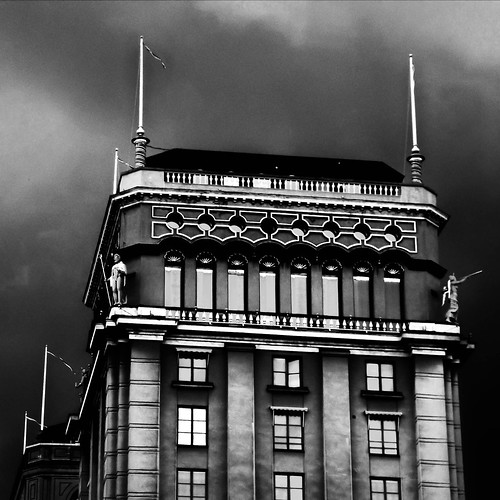 |
| Kungsgatstornet HDR and B/W |
[Admin] Lagging behind
I will keep posting the remaining 8 or so posts for August, post-dated in order. Hopefully I can get them up before September hits.
Saturday, August 27, 2011
Fire dance
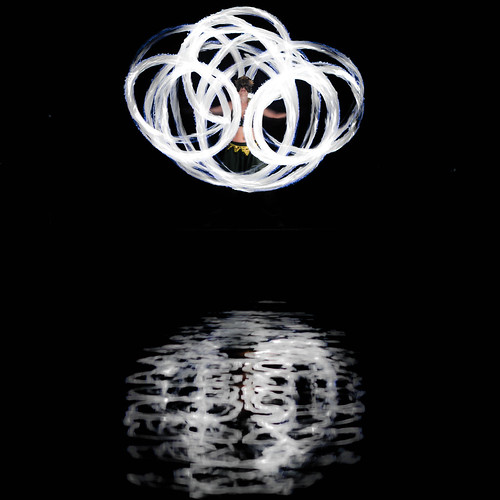 |
| Mirrored Dancer |
However, I discovered that if I remained in color, but worked aggressively with vibrance and saturation controls, I could desaturate the fire dramatically without losing color tone in the dancer's skin or dress. The result is up here — and with what I find to be a very pleasing surprise embedded in what at first glance looks like a black and white picture: the splash of color in the visible fire dancer in the middle of her poi fire streaks.
Friday, August 26, 2011
Mormor Gun
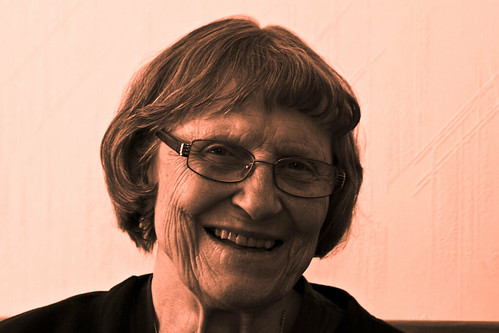 |
| Mormor Gun |
Thursday, August 25, 2011
Cellar door
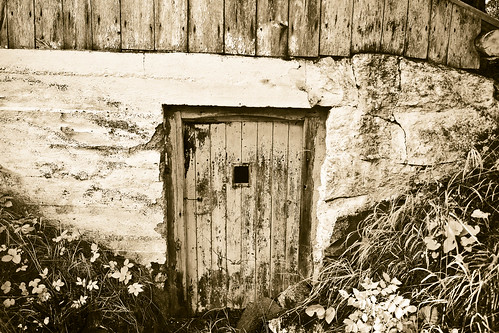 |
| Cellar door |
The two slopes lead the eye to the door at the center of the piece, as do the brick wall veining framing the horizontal streaks of the white wall, and the vertical lines in the top wood lining. The underlying message of «look at this pretty door» is underlined by there being interesting — different, but not unbalanced — textures on all sides of the door itself, complementing its own highly textured appearance with more variation in the picture.
Wednesday, August 24, 2011
Old pumps
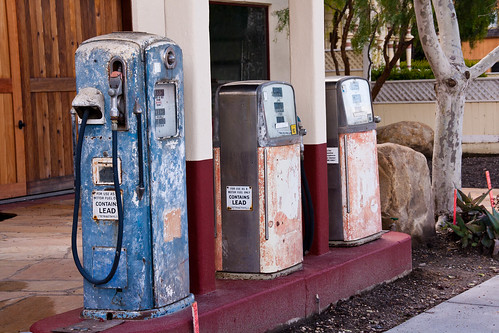 |
| Pumps in Alamo, CA |
To me, these pumps — spotted in Alamo, CA, as we were driving through on our way from SF to LA — speaks of design built to last, of well worn equipment, smoothed out to fit its purpose. It carries a kind of … humanist beauty. The kind of beauty that comes from building something, and then using it for the benefit of the user more than for the item, regarding mere flaking paint as less of a problem than a kinked pipe would be.
Tuesday, August 23, 2011
Odd one out
 |
| The odd one out |
This might be one of the most stock-photo-ish, most commercial-ish photos I have shot. It is such an iconic picture, one that I am far from the first to attempt. And yet, it works so well.
Monday, August 22, 2011
A Swedish summer offering
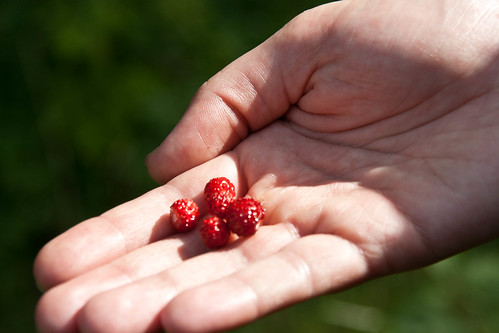 |
| Swedish summer offering |
Were I to do anything different with this shot, I'd frame it slightly more carefully. Avoid the close crop of the finger tips. The crop of the wrist, though, stays. It brings a closeness to the picture, an intimacy with the giver that boosts the underlying mood.
Sunday, August 21, 2011
Thistle
 |
| Thistle |
Saturday, August 20, 2011
Af Chapman
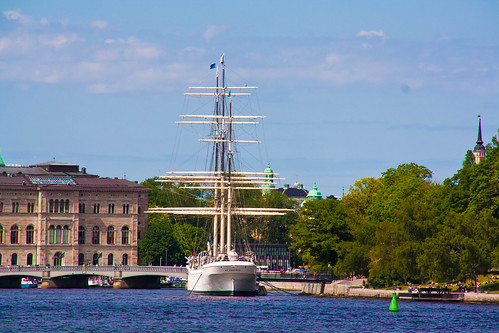 |
| Af Chapman |
Friday, August 19, 2011
In the mood
 |
| In the mood |
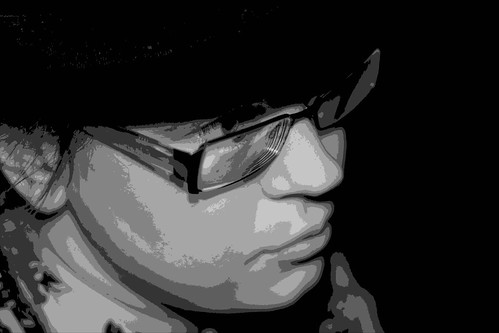 |
| In the mood, etching copy |
Thursday, August 18, 2011
Gritty Tenderloin
 |
| Gritty Tenderloin |
Wednesday, August 17, 2011
Kobe turtle mirrored
 |
| Mirrored turtle in a Kobe inner city park |
Tuesday, August 16, 2011
Olympic tree
 |
| Olympic tree |
Monday, August 15, 2011
Susanne against the future
 |
| Portrait of Susanne |
Sunday, August 14, 2011
Grand Canyon tree
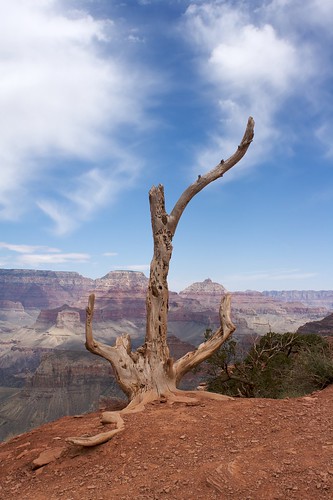 |
| Tree against the Grand Canyon |
Saturday, August 13, 2011
Old and new
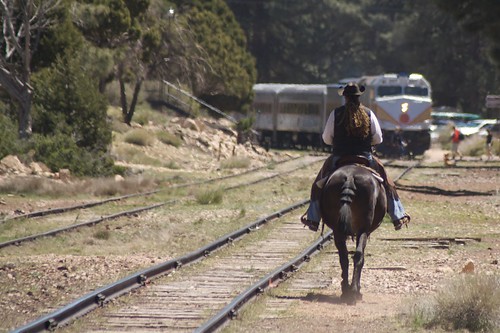 |
| Old and new |
Friday, August 12, 2011
At the groundhogs' at SF Zoo
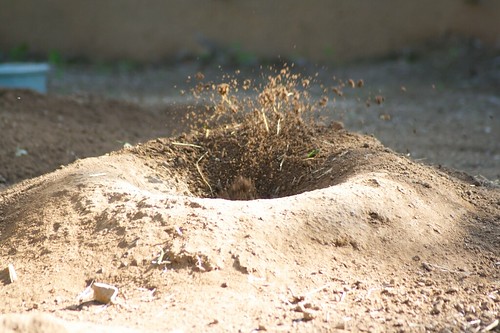 |
| In media res |
Thursday, August 11, 2011
Girl in snow
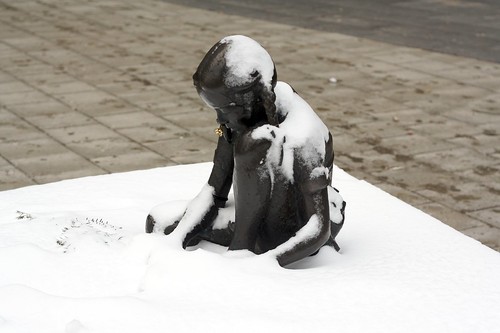 |
| Girl in snow |
Wednesday, August 10, 2011
Isolated flower
 |
| Isolated flower |
Tuesday, August 9, 2011
Muir woods tree
 |
| Muir woods tree |
 |
| Muir woods tree (b/w) |
Monday, August 8, 2011
Airport Fence at FRA
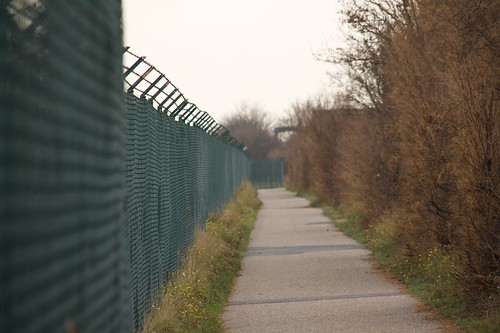 |
| Airport Fence (FRA) |
Sunday, August 7, 2011
Regularity
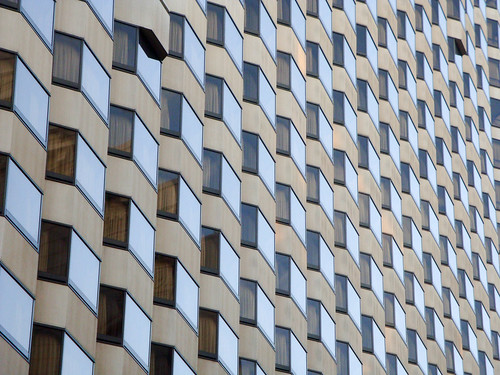 |
| Regularity A skyscraper near Powell Street Station, SF, CA |
Saturday, August 6, 2011
In the heat of battle
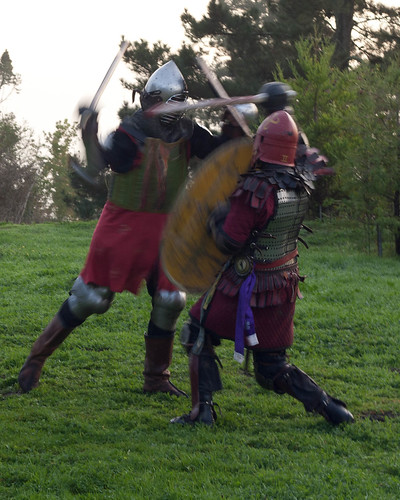 |
| In the heat of battle SCA Fighters at an SCA event with the Shire of Cloondara |
Friday, August 5, 2011
Three Worlds (after M C Escher)
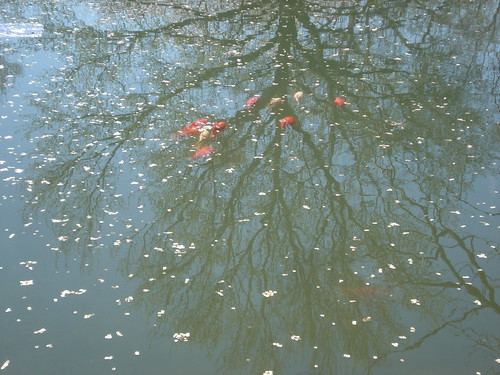 |
| Three worlds — after M C Escher |
A surface interpretation, just looking at the picture and talking about what can be seen will talk about it being a picture of a pond, cherry petals fallen on it, koi visible in it, and the reflection of its environment visible.
One might even go as far as contemplate how the picture pulls together three different worlds — subsurface, surface, and surroundings — into a single whole.
The magic in this picture, the way it speaks to me, however, is all about context and about references. M C Escher, among his many lithographs and various inspired prints, includes in his opus the print Three Worlds:
 |
| Three Worlds — by M C Escher |
Thus, to me, the picture in question mainly evokes M C Escher, and little by little, pretty much his entire corpus of work by way of associations. It starts with Three Worlds, and then the chain of my associations just keeps on rolling onwards from there.
Naturally, this is far from the only way to read the image, and reading it without knowing about the Escher work both evokes the same feelings of unity and alienation in fusion that the lithograph evokes, and brings to mind more thoughts drawn from the particular composition in the image itself.
If anything, I'm curious as to whether the image grows from being rendered in black and white — this image puts some emphasis on the dull green of the water, and the shrill brightness of the cherry petals; emphasis that might fade a little bit with a black and white treatment.

